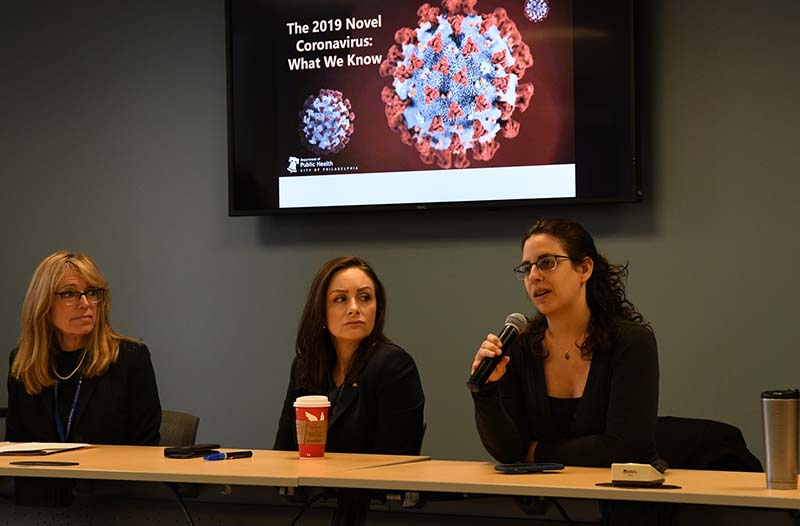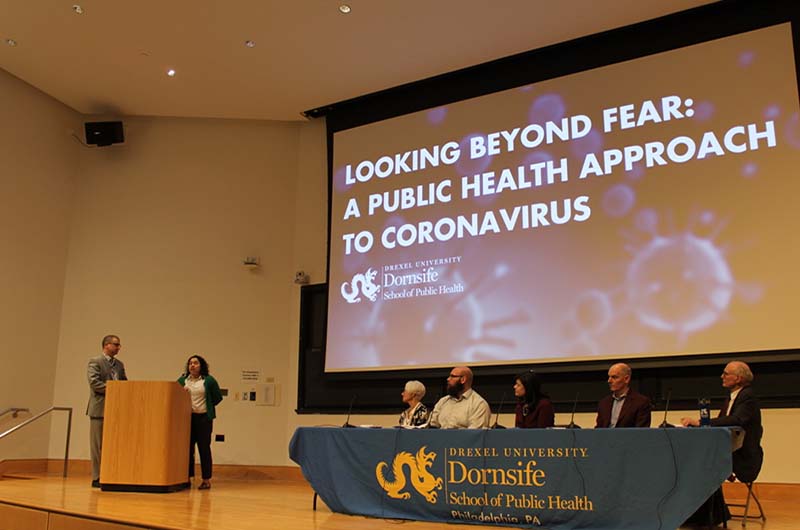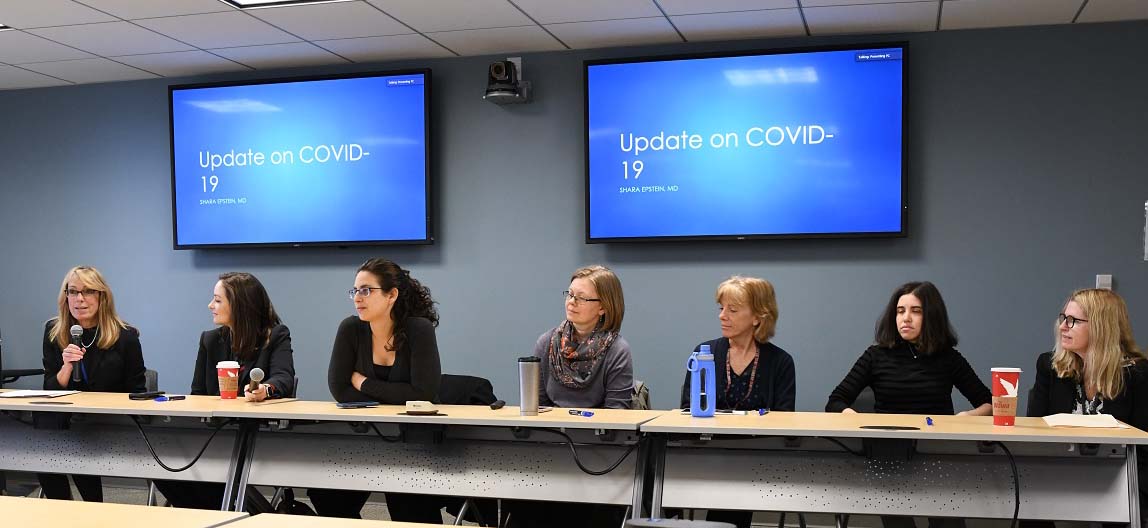Drexel Panels Address COVID-19 Best Practices

Please visit the ‘Drexel’s Response to Coronavirus’ website for the latest information on campus preparations and responses regarding COVID-19.
On March 10, Drexel University hosted two separate panels on COVID-19 during which Drexel experts discussed how health care professionals and the general public can protect themselves, their families and their patients in the time of the new coronavirus.
An event hosted by the Dornsife School of Public Health provided background on how Philadelphia responded to past infectious disease crises, the epidemiology of COVID-19 and the ways in which researchers are tracking the spread of the virus. Additionally, experts relayed how city and state departments of public health, like the Philadelphia Department of Public Health and the Pennsylvania Department of Public Health, function and engage with the federal Centers for Disease Control and Prevention (CDC).
An event promoted by the College of Nursing and Health Professions (CNHP) focused on clinical characteristics, diagnostic and treatment options for COVID-19, as well as how health care professionals can safely care for their patients and themselves with suspected and confirmed COVID-19 cases.
For both events, which were held in-person and through livestream, experts reiterated the importance of engaging in basic safety procedures and precautions like:
- Washing hands with soap for 20 seconds
- Using hand sanitizers with more than at least 60% alcohol
- Using a tissue or elbow while sneezing or coughing
- Avoiding touching one’s face
- Avoiding handshakes and hugging
- Cleaning and disinfecting frequently touched objects and surfaces
- Staying home if you are sick
- Calling a health care provider if you have a fever and cough
- Engaging in social distancing and avoiding large crowds
- Getting a flu shot to avoid getting the flu and needing treatment and resources in a health system burdened by COVID-19
- Being respectful during this time in which people can face significant stigma and discrimination
- Remaining calm
The spread of COVID-19 was also discussed, as it is can be spread in an unknown amount of days after exposure and transmitted through respiratory droplets among close contact (within six feet of an individual with COVID-19 for a prolonged period of time) as well as direct contact with infectious secretions (sputum, serum, blood, respiratory droplets) and contaminated surfaces.
The populations most at risk were identified at the panels: individuals over 60; males, as they have had a higher case fatality risk, though its unknown if that’s because of their biological pathway or health-seeking behaviors; as well as those with cardiovascular disease, diabetes, chronic respiratory diseases and hypertension. Younger people are less at risk, with no reported deaths for children under the age of nine. There’s no evidence of mother-to-child transmission of COVID-19 in pregnant women, though some babies were later infected by their mother after birth.

Both panels discussed safety measures and outcomes for health care workers, who are at a substantial risk for infection due to treating patients with COVID-19 in hospital settings. Michael LeVasseur, PhD, visiting assistant professor in the Dornsife School of Public Health’s Department of Epidemiology and Biostatistics who spoke at the Dornsife event, noted that initially, in China, particularly in Wuhan, health care workers didn’t use adequate personal protective equipment like gloves and masks, and suffered from longtime exposure to large numbers of infected patients during long shifts and a lack of proper infection control training.
“When we’re talking about the health care workers here in America, we want to make sure that they have the proper training, access to the PPE [protective personal equipment] that they need and that we have a large enough supply of workers in our workforce who are healthy enough to come to work,” LeVasseur said at the Dornsife event. “So when we talk about washing your hands, you might not be in one of the groups that are high at risk of dying from this disease or even having serious complications, but at the end of the day, we are all in this together. We are a community in this room. We are a community in this city. And we need to work together to protect those who are most at risk.”
Drexel faculty also acknowledged what is still unknown about COVID-19, including how long it lasts and can be transmissible on different surfaces, whether the respiratory droplets are airborne, if there is a risk of reinfection, how long an incubation period lasts (around five days, typically, though it can be between two and 14 days) and whether warming temperatures will affect its spread. As of yet, there are no proven therapies and no direct pharmacological or antiviral preventions available to change the course of infection of COVID-19.
These Drexel experts also summarized the origins and characteristics of COVID-19, tracking its spread from China in December 2019 to countries around the world in the proceeding weeks and months. COVID-19’s similarity and differences to other viruses in the coronavirus family, like influenza, SARS (severe acute respiratory syndrome) and MERS (Middle East respiratory syndrome) were also discussed.
Both events had been planned weeks ago, when COVID-19 first began spreading. The scale, function and audience of the events expanded accordingly, while their missions remained the same: to inform the community using the University’s vast and rich faculty expertise and to engage with Drexel Dragons during this time of fear and uncertainty. Both events ended up being held on the day that Philadelphia announced its first presumed positive case of COVID-19.
“Looking Beyond Fear: A Public Health Approach to Coronavirus”
The speakers at the Dornsife School of Public Health’s event, “Looking Beyond Fear: A Public Health Approach to Coronavirus,” were from Dornsife as well as the Drexel University College of Medicine and Student Life. That event can be watched in full below.
The Dornsife School of Public Health panel was moderated by Michael Yudell, PhD, professor and chair of the Department of Community Health and Prevention.
Each member gave a short talk about their expertise in relation to COVID-19. The speaker panel of Dornsife experts included:
- Esther Chernak, MD, associate professor and director of the MD/MPH degree program in the Department of Environmental and Occupational Health and director of Dornsife’s Center for Public Health Readiness and Communication. Chernak discussed the virus’ clinical manifestations, diagnosis and transmission characteristics, treatment and prevention.
- Michael LeVasseur, PhD, visiting assistant professor in the Department of Epidemiology and Biostatistics. LeVasseur explained its basic reproductive rate (R0, or the average number of infections per person transmitted from a single infected person), case fatality rate (CFR, or the number of people who died out of a number of cases) and mortality rate (the number of people who died out of a total population) — and why all of those numbers differ drastically between countries due to the lack or underreporting of testing for cases.
- James Buehler, MD, clinical professor and interim chair of the Department of Health Management and Policy and former health commissioner of Philadelphia. Buehler shed a light on how health departments at different local, state and federal levels work and interact together; the CDC provides guidance, assistance and funding to state and local departments, who work to protect and serve their populations and call on the CDC for help.
- Joseph Amon, PhD, clinical professor in the Department of Community Health and Prevention and director of Dornsife’s Office of Global Health. Amon detailed how different countries have responded to the novel coronavirus outbreak — China’s totalitarian government shut down large parts of the country as a containment measure, for example, and how Italy, with a different system of government, is starting to do the same — and being mindful of how different people and populations are most vulnerable to xenophobia, and who can afford to be quarantined.
- Annette Molyneux, PhD, assistant vice president, Student Life and director of the Counseling and Health at Drexel. Molyneux reminded the audience that there is a large emergency preparedness team at Drexel with people from across the University working together to play a part in the decision-making process that ultimately affects all Drexel students, faculty and professional staff.
- Janet Cruz, MD, assistant professor in the Department of Family, Community & Preventive Medicine at the College of Medicine and medical director of Drexel Student Health. Cruz explained how the Drexel Student Health Center on campus engages with students to try to educate them, and has implemented protocols for taking in the concerns of students, faculty and staff. [In the event you are a student who becomes ill, please contact the Student Health Center 215.220.4700. Guidance for faculty and professional staff will be provided shortly.]
“I think when we kind of all join in, this is a collaborative effort and all of you are part of that, right?” Cruz told the audience. “It all starts with each one of you taking those small steps and really emphasizing hygiene. We all have our sets of responsibility. … we all have a role to play in this. Be mindful of others. Educate others. And really take the time to practice those good hygiene practices.”
“Tuesday Topic: Preparing for Potential Pandemic: A Panel Discussion on Best Practices for Health Professionals for Dealing with the Coronavirus”

The College of Nursing and Health Professionals’ event was called “Tuesday Topic: Preparing for Potential Pandemic: A Panel Discussion on Best Practices for Health Professionals for Dealing with the Coronavirus.” It featured a group of interdisciplinary experts from the CNHP, as well as the College of Medicine and the Philadelphia Department of Public Health.
Every week, the CNHP has hosted “Tuesday Topics” informal discussions in which College faculty and staff share their expertise on external topics in the news as well as internal opportunities. The March 10 event was part of this series and can be watched in full below.
“Our goal in setting up this symposium or ‘Tuesday Topic’ is to talk to you,” Deborah Clegg, PhD, associate dean of research at the College of Nursing and Health Professions, told the audience. “We have some phenomenal experts. … We want to send you away with a really calming message and a message that you can send on to others.”
In addition to Clegg, the speaker panel at the College of Nursing and Health Professions event included:
- Merritt Brockman, DHA, assistant teaching professor in the Health Administration Department at the College of Nursing and Health Professions.
- Shara Epstein, MD, assistant professor of medicine in the Division of Infectious Diseases & HIV Medicine at Drexel University College of Medicine.
- Tiina Peritz, Healthcare-Associated Infections/Antimicrobial Resistance (HAI/AR) program manager in the Division of Disease Control at the Philadelphia Department of Public Health
- Susan Solecki, DrPH, assistant clinical professor in the Division of Graduate Nursing in the College of Nursing and Health Professions.
- Alison Rusgo, assistant clinical professor in the Physician Assistant Department in the College of Nursing and Health Professions.
- Theresa Fay-Hillier, DrPH, associate clinical professor in the Department of Undergraduate Nursing in the College of Nursing and Health Professions.
During the panel, Epstein and Peritz gave presentations, and all panelists were available to speak and answer questions from the in-person and digital audience. Epstein focused on the clinical aspects of COVID-19, including its symptoms, the clinical course of treatment, radiological findings, outcomes and treatments, mortality rates.
Peritz discussed the public health treatment of the disease, including how agencies are working to prevent the spread of disease through travel screening, testing, quarantine, isolation, contact tracing, airborne and respiratory precautions, providing personal protective equipment for those taking care of sick people and social distancing. Petiz also detailed how to monitor those at:
- High risk: people living with or providing care in the home of someone with COVID-19 without the use of recommended precautions.
- Medium risk: close contact with someone with COVID-19 but using recommended precautions, or travel from affected areas like China, Iran, Italy and South Korea that are on the CDC’s Warning Level 3 travel alerts.
- Low risk: being in the same indoor environment with someone who has symptoms but not with close contact.
At both the Dornsife School of Public Health and CNHP events, Drexel experts implored Dragons to stay safe, stay calm and be prepared.
“Doing these kinds of things, more than anything else, can help to prepare,” said Fay-Hillier at the CNHP event, noting that when there’s fear or an “unknown,” people can become obsessed with consuming media all of the time and can forget to take care of themselves or be aware that there are vulnerable populations that are targeted.
Drexel News is produced by
University Marketing and Communications.

